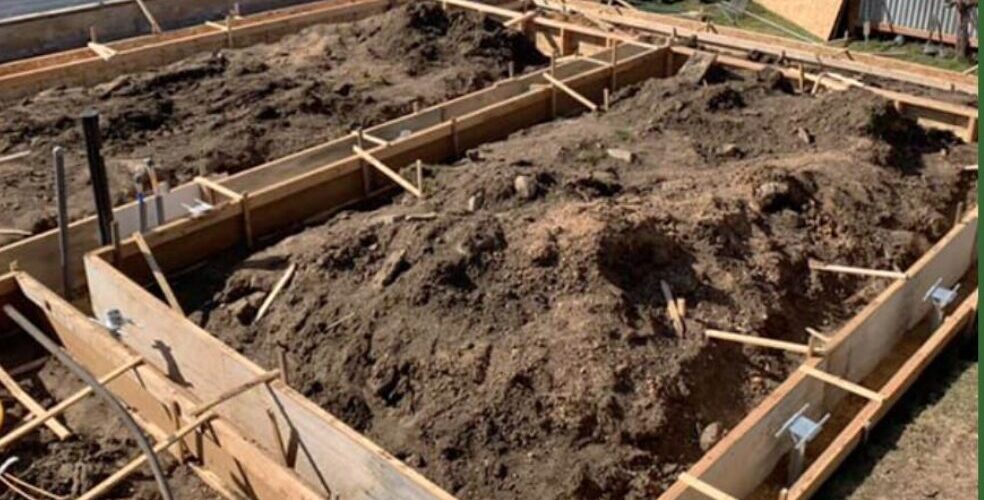Complex soil conditions in the Mid-Atlantic often make traditional foundations impractical. Helical pile systems offer a proven solution that delivers high load capacity, fast installation, and verifiable performance even in low-bearing or saturated soils.
This overview examines helical pile technology from a design and installation perspective, addressing selection criteria, soil interaction principles, and application scenarios common to commercial and industrial projects in the Mid-Atlantic and Northeast.
Soil Mechanics and Foundation Performance
Understanding how soil characteristics affect foundation performance is essential for selecting the proper pile system.
Shallow foundations depend on near-surface soil layers to distribute structural loads. However, many sites present bearing capacity challenges:
- Soft or compressible soils (organic clay, silt, peat) that cannot accommodate the bearing pressures of conventional foundations
- High water tables that compromise drainage and accelerate settlement
- Fill soils with variable compaction and uncertain engineering properties
- Expansive or seasonally sensitive soils subject to frost heave or moisture-related movement
In these conditions, helical piles bypass problematic upper strata by advancing to deeper, competent bearing layers. Helical pile design requires a geotechnical site investigation to establish soil stratigraphy, bearing capacity at depth, and torque-to-capacity correlations specific to site conditions. When properly designed, helical systems provide reliable axial, tension, and lateral resistance without large-scale excavation or concrete curing delays.
Helical Pile Technology and Design Principles
A helical pile is a steel shaft with one or more helical plates (flights) welded to the shaft. The pile is rotated into the ground to a target embedment depth where soil conditions provide adequate bearing capacity and resistance to uplift and lateral loading.
Design Parameters:
- Torque monitoring during installation establishes actual bearing capacity through correlations between installation torque and axial load capacity
- Plate diameter and shaft size are selected based on load requirements and soil properties
- Multi-helix configurations increase capacity for heavily loaded applications
- Installation depth is determined by geotechnical investigation and design calculations
Helical piles function through end-bearing (soil capacity beneath the lowest helix) and skin friction (resistance along the shaft), depending on the soil profile and depth. Design standards follow guidelines established by IECC, NFIP, and the International Code Council, with capacity verification through full-scale testing or correlation with recognized torque methods.
Advantages for Commercial Applications
- Rapid installation: Most commercial projects can complete pile installation in 1-3 days with minimal site disruption
- Year-round installation: Weather-independent operations reduce schedule delays
- All-terrain capability: Equipment can access confined spaces, utilities, and areas where excavation is restricted
- Verifiable capacity: Real-time torque data provides documented proof of bearing capacity to meet QA/QC requirements
- Adaptability: Adjustable lengths and multi-helix options accommodate varied load distributions and settlement requirements
- Cost efficiency: Reduced labor, equipment, and material waste compared to driven pilings or extensive ground improvement
Common Project Applications
Helical piles have become the standard solution for:
- Building additions and modifications where retrofitting shallow foundations is impractical
- Bridge and boardwalk structures requiring foundation systems in water or saturated soils
- Telecommunications towers and other lateral-load-sensitive structures
- Industrial equipment foundations are subject to dynamic or vibration loads
- Foundation repairs addressing settlement or underpinning of existing structures
Case Study: Avalon Yacht Club — Deck Foundation Design in Weak Surface Soils
A recent project at the Avalon Yacht Club in Avalon, New Jersey, demonstrates how helical piles address real-world design challenges common to coastal and fill-soil environments.
Project Application:
A deck addition required deep foundations capable of transferring load below weak surface soils without large excavations.
Design & Installation Highlights:
- Pile Type: 2 7/8″ pipe piles (.276 wall) with beam-seat brackets
- Quantity: 7 piles supporting the deck structure
- Depth: Approximately 20 feet to reach competent material
- Ultimate Capacity: 12 tons, verified through installation torque of 5,400 ft-lbs
- Equipment: Compact Bobcat mini-excavator for restricted access zones
Site Challenges:
- Low overhead clearance due to existing roof eaves limited the pile segment length to 5-foot leads
- Subsurface obstructions (old concrete slabs) required strategic alignment
Weak near-surface soils are unsuitable for shallow footings
From a design perspective, this project highlights:
- The value of torque-to-capacity verification
- The ability to install in confined areas where driven piles or caissons would be impractical
- Reliable capacity in saturated coastal soils
- Minimal disturbance adjacent to active public spaces
For coastal commercial properties—where fill soils and high water tables are common—this installation approach is often the most cost-effective and technically sound solution.
Read the full case study here.
Design Considerations and Best Practices
Successful helical pile projects require:
- Adequate geotechnical investigation to establish soil profiles and design parameters
- Capacity verification through torque correlation or load testing, documented per ICC standards
- Structural design integration accounting for pile group effects, deflection, and load distribution
- Installation quality control with certified installers and real-time monitoring of installation torque and depth
The Mid-Atlantic region’s geotechnical variability demands site-specific analysis. Our team provides engineering support to establish pile capacity, verify bearing adequacy, and ensure installations meet design specifications and local building codes.
For architects and engineers facing complex foundation challenges, helical pile systems offer a technically sound, well-documented, and efficient alternative to conventional approaches. When soil conditions make traditional foundations problematic or costly, helical technology provides a path to project feasibility and cost optimization.
At Danbro Distributors, we partner with design professionals to evaluate helical solutions, verify capacity, and execute installations that meet specification requirements and code compliance for commercial and industrial projects.
Contact our team for site-specific load testing, torque correlation data, or design assistance on your next foundation project info@danbro.com.





No comments yet.